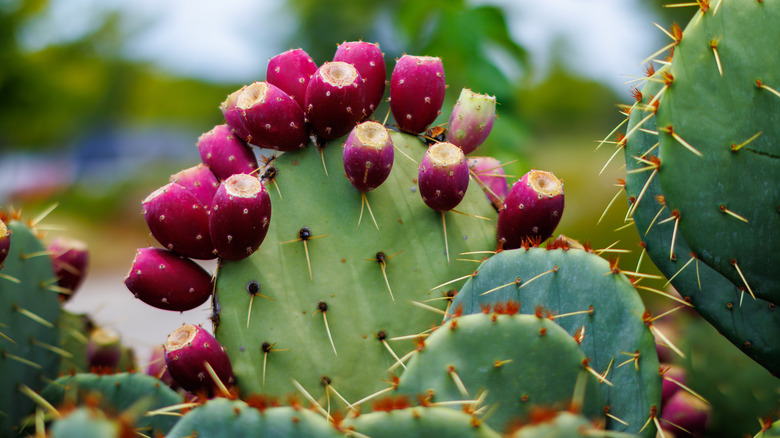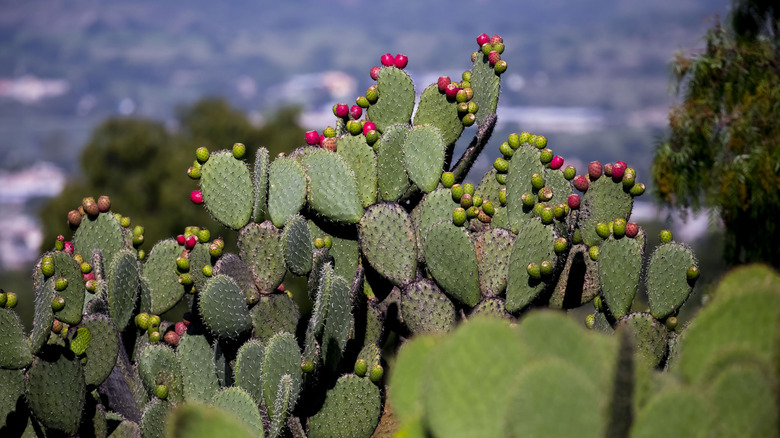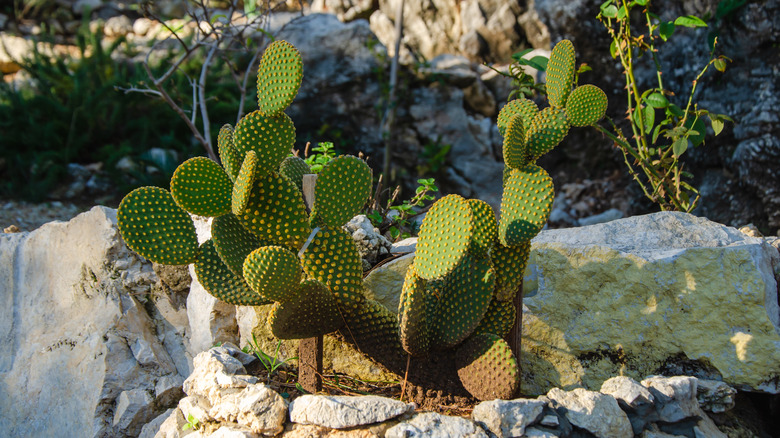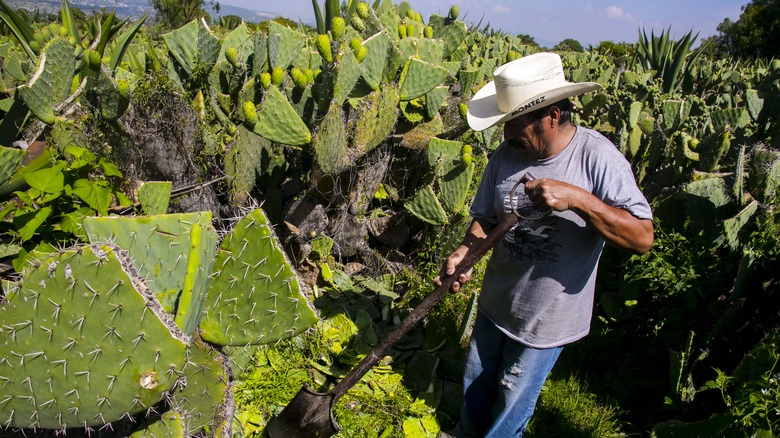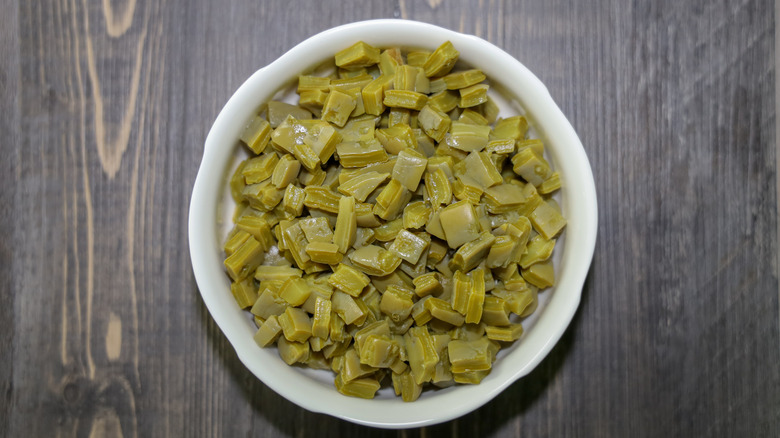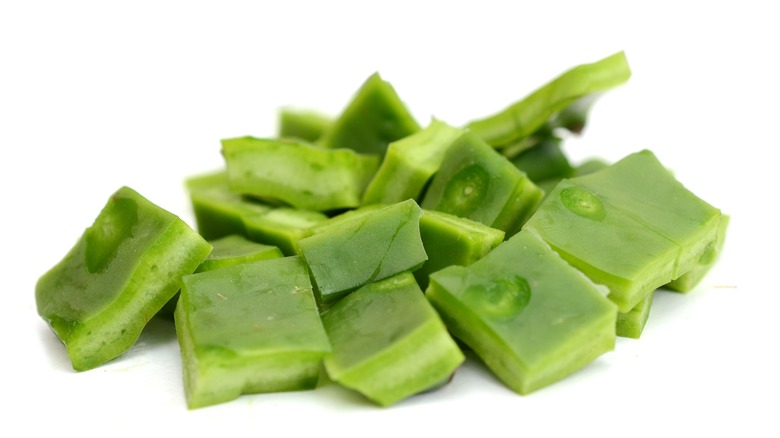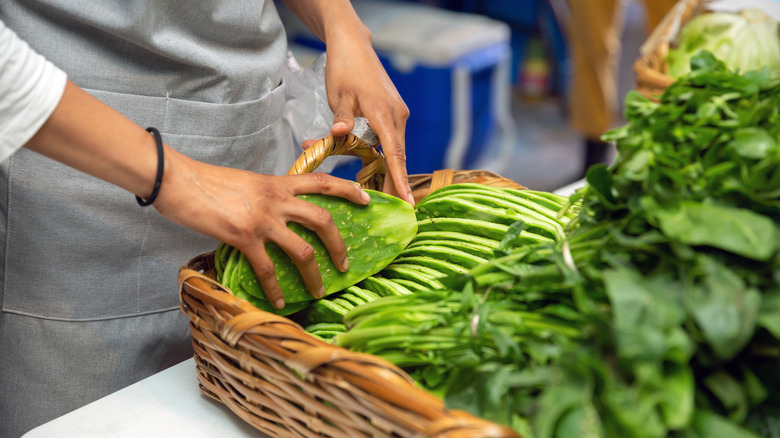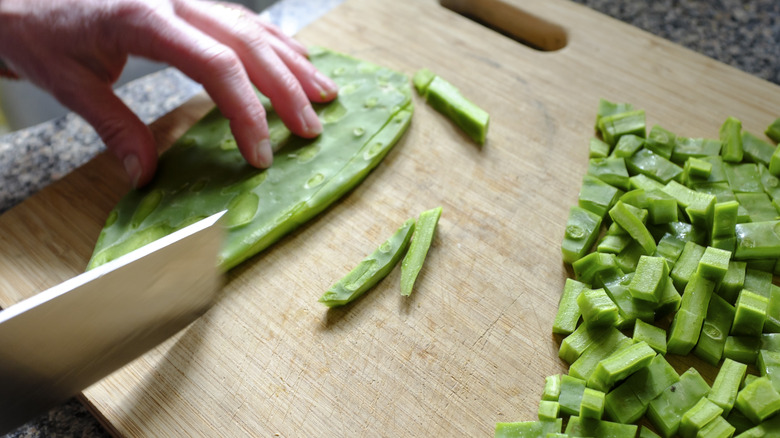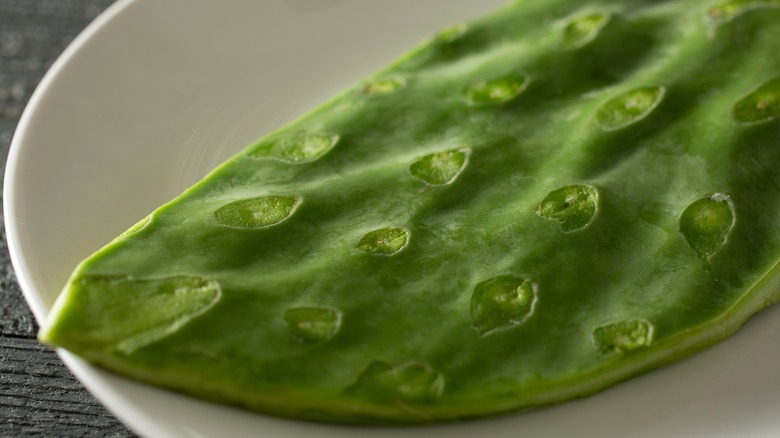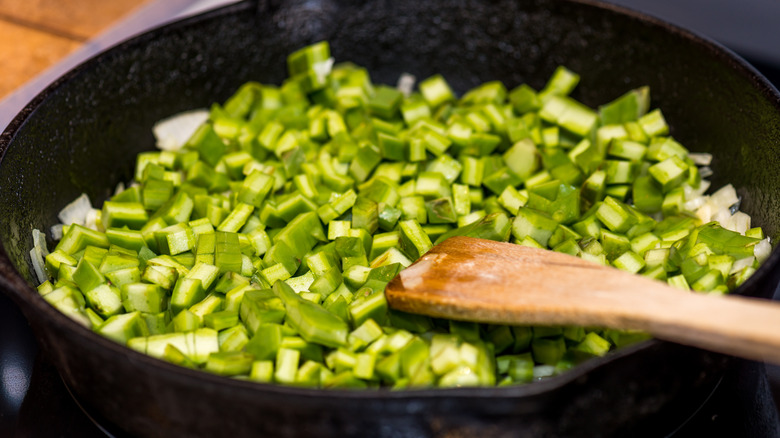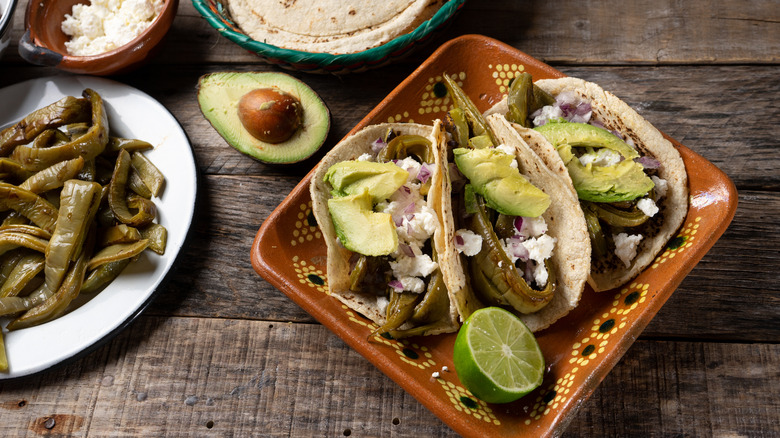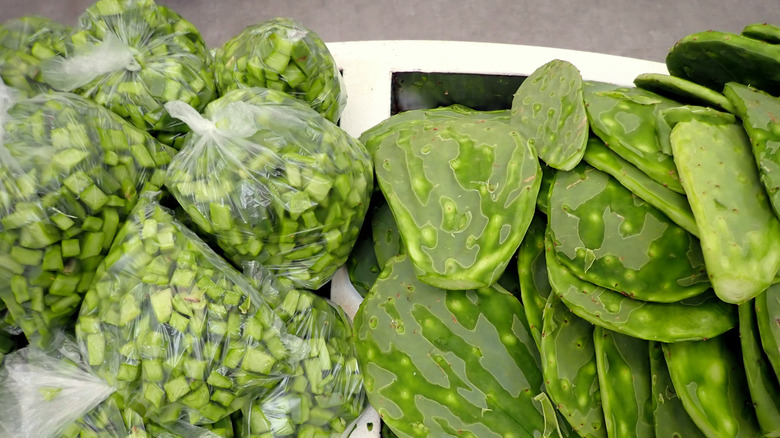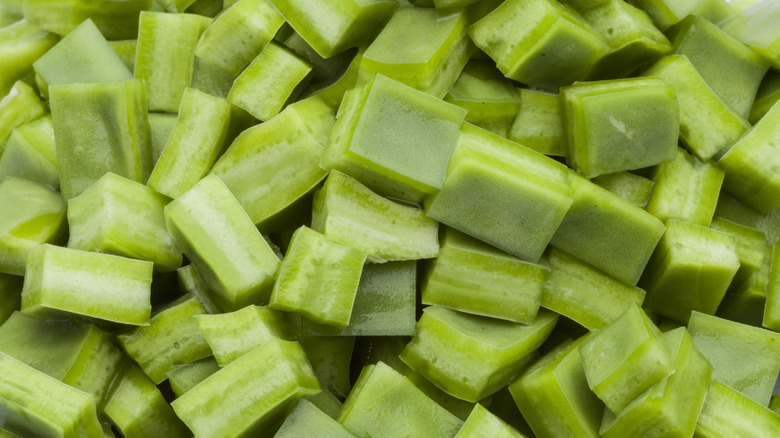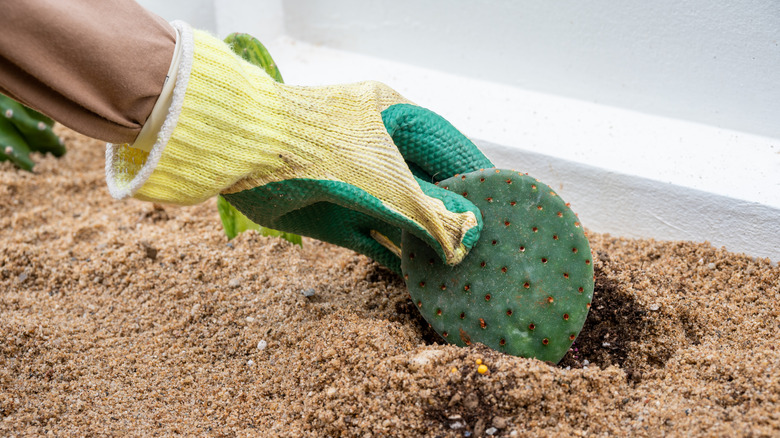Everything You Need To Know About Nopales
If you've spent any time in Mexico or the American Southwest, you may have come across nopales at restaurants or in home cooking. Also called nopalitos, they're used in a wide range of dishes, from eggs to tacos, salads, stews, and salsas. When cooked, they look similar to okra or bell peppers and have a mild vegetable taste — but what exactly are nopales? Where do they come from and how do you cook with them?
A nopal is a cactus with wide, flat paddles called nopales and fruit called prickly pears. Although the cacti are native to the Americas, they've become a symbol of Mexican cuisine and heritage. At first glance, nopales look rather intimidating with their sharp spines. However, they're actually relatively easy to prepare and cook. Plus, they're nutritious and delicious.
If you're looking for a unique ingredient to incorporate into your cooking, nopales can add some south-of-the-border flair to your dishes. Depending on where you live, you may be able to find them in grocery stores, Latin American markets, or even in your own backyard. Here's everything you need to know about these interesting vegetables including how to cook with them.
What are nopales exactly?
The nopal cactus is part of the genus Opuntia, which is native to North and South America. Also called the prickly pear cactus, this genus has large flat pads called cladodes with spiky thorns and hairy spines called glochids. The cacti also grow brightly colored flowers and develop fruits called prickly pears (or tunas in Spanish) that also have thorns. The nopales are the fleshy pads of the cacti.
Opuntia cacti are hardy perennial succulents that can grow in harsh environments. They can handle both hot and cold temperatures but prefer sunny, arid areas like deserts and rocky landscapes. They are adept at storing water, so they do well even amid droughts. Because of their adaptable nature, you can now find them in places as widespread as Australia, Africa, and Europe.
The nopal cacti can vary considerably in size, ranging from about three feet to 15 feet tall. The nopales grow upwards and to the sides and are connected by joints. This gives the plants a stacked or layered look. Nearly all parts of the cacti are edible, including the nopales, flowers, and the prickly pears. However, you need to remove the thorns and glochids because they can get stuck in the skin and throat.
Varieties of nopales
There are over 300 species of Opuntia cacti that come in all shapes and sizes and grow all over the world. You can find roughly 100 of these species in Mexico and the United States. The most common species grown mainly for its nopales is the Opuntia ficus-indica. That's because this particular species has thick, fleshy pads that provide a lot of flesh. It grows quite tall and can handle a wide range of weather conditions including rain, humidity, and drought.
Other types of Opuntia cacti are often grown for the prickly pear fruit rather than the nopales. These include Opuntia quitensis with its sweet fruit and Opuntia Actual, which has few seeds. There are also hybrid Opuntia that have been bred to have little to no spines or glochids. In addition, you can also find ornamental Opuntia cacti that look attractive but may not be ideal for eating the nopales because the pads may be thin, covered in glochids that can be hard to remove, or just not as juicy as the nopales you get from Opuntia ficus-indica.
The importance of nopales in Mexican history and heritage
Much like agave and maize, the nopal cactus has been a staple food source in Mexico for centuries. According to the Food and Agriculture Organization, indigenous people in Mexico were cultivating Opuntia as far back as 7,500 B.C. Even before that, people used wild Opuntia for food, drink, medicine, and spiritual practices. After cattle were introduced in the 1600s, the cacti were also used as livestock feed, especially during times of drought.
The nopal cactus is so ingrained in Mexican culture that it appears on the Mexican flag. Legend has it that when the Aztecs were looking for a new home, the gods told them to look for an eagle eating a snake on top of a nopal (cactus) in the middle of a lake. That's exactly what they saw when they arrived at Texcoco Lake in Central Mexico, so they settled there and created the city of Tenochtitlan. That city would eventually become Mexico City. The image of the eagle and snake on the cactus is now the national emblem of Mexico.
What do nopales taste like?
Boasting a vibrant green color, nopales have a firm exterior and a soft interior that can be wet and sticky. When chopped or sliced, nopales look like green chilies or cut bell peppers. However, they have a taste that's all their own. When eaten raw, they have a tart, green flavor. Some say raw nopales also offer hints of lemon. Cooking the nopales brings out the sweetness and enhances the vegetable flavors. Some compare the taste and texture of cooked nopales to asparagus or green beans.
The other commonly eaten part of the nopal cactus is the prickly pear fruit, which grows along the sides of the cactus pads. The pear-shaped fruits vary in color from green to yellow, orange, red, and dark purple. Once you remove the spiny glochids and remove the peel, the fruit inside is typically sweet and juicy. Some compare it to watermelon or kiwi. Less ripe prickly pears will be slightly sweet with a touch of tang. The fruit is often used to make jellies, jams, and syrups. People also drink the juice on its own or use it in cocktails and mixed drinks.
The nutritional value of nopales
Nopales are a great addition to your meal if you want to amp up the nutritional value. The cactus pads are packed with calcium, magnesium, and fiber. They also contain vitamins A, C, and K. Like many vegetables, nopales are low in fat, cholesterol, and calories. The sugar and sodium content is also quite low. Nopales contain a good amount of water, which can provide hydration and make you feel full faster. In addition, nopales are high in antioxidants and contain anti-inflammatory properties.
Although research on the health benefits of nopales is limited, some studies reveal they may be useful in treating and managing certain health conditions. A 2014 study published in the Journal of the Academy of Nutrition and Dietetics observed type 2 diabetes patients who consumed nopal, along with a high-carbohydrate breakfast. They had significantly lower blood sugar levels than patients who only ate the carb-heavy meal. Another 2014 study states that compounds in the nopal cactus may have antimicrobial and neuroprotective properties. A 2016 study published in Molecules suggests that extracts of Opuntia ficus-indica can reduce some hangover symptoms, such as dry mouth and nausea, if consumed before drinking alcohol.
What to look for in nopales
Nopales typically start growing new pads in the spring when the weather warms up. Many people harvest them in the spring and summer when they're about five to six inches long and still tender. It's around this time that you might see nopales appearing in grocery stores and specialty markets. You may find whole pads with the spines and glochids intact or removed. Some spots also sell pre-chopped nopales.
When shopping for fresh nopales, you want to look for pads that are bright green. Those will typically be the ripest and freshest. The texture should be firm, but also slightly tender to the touch. Avoid nopales that are soft and limp or pale in color and tough. Those are good indicators that the pads are not as fresh as they could be or that they were harvested too late in the season.
If you can't find fresh nopales, you may be able to find jarred nopales. They may be labeled as "nopales," "nopalitos," or simply "tender cactus." Jarred nopales are often marinated in vinegar and seasonings. They can be slightly salty, so you may want to rinse them before adding them to your dishes.
How to prepare nopales
The first thing you want to do with fresh nopales is remove the spines and glochids (if they still contain them). It's best to wear gloves because the tiny spines can embed themselves into the skin and they're very hard to remove. Lay the cactus paddle on a flat surface and use a sharp knife to slice and shave the thorny bits off. Be sure to get the spines along the edges as well. Alternatively, you can use a torch to burn them off. Once all the thorns and glochids are removed, wash the nopales to get rid of any leftover debris.
While some vegetables require special cutting techniques to get rid of seeds and deal with unwieldy shapes, de-thorned nopales are pretty easy to prepare. All you need to do is slice the pads into strips or dice them into cubes. The method you use depends on how you're going to cook them and the dish you want to use them in. For example, you might want big chunks of nopales in a salad, while tacos can benefit from long strips that will nestle nicely into tortillas.
Can you eat raw nopales?
One of the most common questions people have about nopales is whether you can eat them raw. The answer is a resounding yes. Once all of the spines and glochids have been removed, you can simply eat the cactus paddle as-is or slice, dice, or chop it and throw it into salads, salsas, or soups. Raw nopales offer a nice crunch from the skin and a soft, juicy interior that is slightly tart, a bit sweet, very refreshing, and clean-tasting.
Another way that people use raw nopales is in juices and smoothies. Jugo verde is a popular Mexican drink that often contains nopales blended with other ingredients like pineapple juice, celery, cucumber, and parsley. You can also make cocktails with juice from nopal cactus paddles. Think a smoky pineapple margarita with mezcal, pineapple juice, and cactus juice or a cooling gin and tonic garnished with a slice of nopal. You can also juice the cactus pads and enjoy the pure nopal juice on its own as a healthy and refreshing way to start the day or to cool off on a hot afternoon.
How to cook nopales
Cooking nopales is a great way to soften them and bring out some of the sweeter notes. It will also get rid of some of the slimy texture in the flesh. One common way to cook nopales is on the grill. Just brush the nopales with oil, then grill them whole for about five to six minutes on each side until the outside is slightly charred. You can also score or partially slice the nopales first to help cook the insides faster and allow more of the water to evaporate for firmer, less viscous interiors.
Boiling is another popular cooking method for nopales. Just chop your nopales, throw them in a pot of boiling water, and cook for about 10 to 15 minutes until the nopales are tender. You can also simmer chopped or sliced nopales directly in soup with other veggies and seasonings. Sauteeing is another option for sliced or chopped nopales. Keep in mind that nopales have a very mild flavor, so they tend to take on the flavors of other ingredients like cooking fats, seasonings, broths, and sauces.
Popular nopales dishes
Being the versatile vegetables that they are, nopales are used in a wide array of Mexican and Southwestern dishes. One of the easiest and most popular dishes is nopales a la Mexicana. It typically features chopped and sauteed nopales, onions, tomatoes, and chili peppers like jalapeños or serrano peppers. You can use it as a side dish, pile it into tortillas, or use it as a topping for other dishes like grilled flank steak tacos or quesadillas. If you're not a fan of spice, just take out the chili peppers.
For a tasty and nutritious breakfast dish, consider nopales con huevos (nopales with eggs). Just chop your nopales, boil them until tender, then saute them with onions and scrambled eggs. You can eat the dish on its own or wrap the mixture up in a tortilla. Ensalada de nopales is a tasty salad typically made with nopales, tomatoes, onion, cilantro, lime juice, and queso fresco. Nopales can also be cooked with meat or potatoes and served in tacos with toppings like avocado, pico de gallo, and salsa.
How to store nopales
Nopales are pretty hardy vegetables, so you can store them for some time before they go bad. The key is to keep them in a cool, dry, and well-ventilated space. One member of Tortoise Forum reported their nopales lasted for three to four months in the shade outside. If your cactus paddles have the spines cut off or they're chopped, you should store them in the refrigerator. They should keep anywhere from one to two weeks. If your nopales are already cooked, they should be good for about five to seven days in the fridge.
Depending on where you live, nopales may only be available at certain times of the year. In that case, you may want to stock up and freeze your nopales. Fortunately, they freeze quite well. You can simply wash and dry the whole cactus pads and put them in an air-tight freezer bag. Blanching is a great technique for freezing green vegetables because it helps preserve their color and flavor. It involves boiling the nopales for a few minutes and then dunking them in ice water. Drain them off, pack them in airtight bags, and they should last anywhere from six months up to a year in the freezer.
Other uses for nopales
Nopales aren't just delicious food sources, they can also be used for a wide array of products. If you want the health benefits that nopales can provide but aren't fond of the taste or texture, there are several holistic health products on the market. Supplements include concentrated nopales in liquid form, powder, and capsules.
Skincare brands are also picking up on the nutrient-giving benefits of nopales. The flesh is high in vitamin C, which can encourage collagen production and help brighten dull skin. It also contains betalains, which can help reduce inflammation and redness. The water-rich flesh can also help soothe sunburns.
Some nopal farmers also make dyes from cochineal insects that live on the cacti. Also called carmine, cochineal dye is a natural colorant with a bright red hue that can be used to color food, cosmetics, and textiles. The next time you pick up a pint of strawberry ice cream or a slice of red velvet cake, you may just have the nopal cactus and its tiny hosts to thank for the reddish or pinkish color.
Growing nopales
Growing nopal cacti is easier than you might think. Highly adaptable, the plants can be propagated from cactus pad cuttings. All you need is a mature cactus pad (about six months or older) cut at the joint where it connects to the rest of the plant. Keep the cutting in a dry, well-ventilated area and wait for the cut part to heal. Then you can simply stick the pad into the ground or plant it in a pot with the cut side about one inch below the surface.
The Opuntia cactus likes sandy soil and full sun. It doesn't need to be watered too often, especially in the beginning when it's first beginning to form roots. A good rule of thumb is to water it about one month after planting it and then every two or three weeks after that. If you're growing your nopal cactus specifically for the nopales, you may want to consider using a fertilizer with plenty of nitrogen. Keep an eye out for cochineal insects, as they can suck the juices of the plants, causing browning and even death. The insects often look like fluffy cotton on the cacti. You can get rid of them with insecticide or natural insect repellents.
